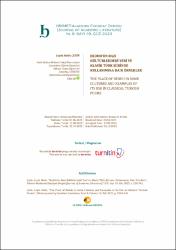| dc.contributor.author | Çetin, Leyla Melis | |
| dc.date.accessioned | 2024-04-30T09:58:47Z | |
| dc.date.available | 2024-04-30T09:58:47Z | |
| dc.date.issued | 2023 | en_US |
| dc.identifier.citation | ÇETİN, Leyla Melis. "Beduh'un Bazı Kültürlerdeki Yeri ve Klasik Türk Şiirinde Kullanımına Dair Örnekler". Hikmet - Akademik Edebiyat Dergisi, 19 (2023): 318-341. | en_US |
| dc.identifier.uri | https://dergipark.org.tr/tr/pub/hikmet/issue/80807/1309336 | |
| dc.identifier.uri | https://hdl.handle.net/11352/4912 | |
| dc.description.abstract | Beduh karesinin ilk şekli, Çin kültüründe efsanevi bir şekilde ortaya çıkan ve “Lo Shu” olarak isimlendirilen, 2, 4, 6, 8; 1, 3, 5, 7, 9 sayılarının meydana getirdiği sihirli bir kare olarak görülmüştür. Lo Shu Çin kültüründe bir tılsım olarak kullanılmış ve kültür aktarımı sonucu farklı kültürlerde de farklı şekillerde yer almıştır. Hint ve Batı kültürlerinde de farklı isimlendirmelerle sihirli bir kare ve tılsım olarak görülmüş ve kullanılmıştır. Arap kültüründe ise “Beduh” ismiyle bir vefk olarak yer almıştır. Sayısal değerleri 2, 4, 6, 8 olan sihirli bir kare biçiminde resmedilen Beduh ifadesi mezkûr kültürlerde çeşitli bakış açısı ve farklı isimler ile ele alınmış ve çeşitli alanlarda bu kareden istifade edilmiştir. Kültürlerin etkileşimi sonucu Arapların etkisi ile birlikte Türk kültüründe de “Beduh” ismi ile yerini almıştır. Beduh ifadesi Eski Türk kültüründe yazılan mektupların ulaşması gereken yerlere güvenle ulaştırılabilmesi amacıyla mektupların çeşitli noktalarına sayısal değerleri ile birlikte yazılmış ve bazı amaçlar doğrultusunda hazırlanan vefklerde de söz konusu olmuştur. Bazı sözlüklerde koruma ile görevli bir melek olduğu veya Allah’ın bir ismi olduğu yönünde ifadeler yer almıştır. Yürüme, yürüyüş anlamıyla da ele alınan Beduh klasik Türk şiirinde şairin anlam ve ifade dünyasını etkilemiştir. Şair, beyitlerde âşığın sevgiliye olan muhabbetinden bahsederken Beduh ifadesinin bir tılsım olarak farklı yönlerine dikkat çekmiştir. Bu çalışmada Beduh ifadesinin Çin, Hint, Batı, Arap ve Türk kültürlerindeki yeri ile birlikte Klasik Türk şiirine olan yansımalarına dair örneklere yer verilmiştir. | en_US |
| dc.description.abstract | The first shape of the Beduh square is a magical square in Chinese culture. This shape is called “LoShu” and is made of the numbers 2, 4, 6, 8; 1, 3, 5, 7, 9. LoShu is used as a talisman in Chinee culture and transferred to other cultures in different shapes as a result of cultural interaction and transmission. It is perceived and used in Indian and Western cultures under different names, similar to talismans and magical squares. In Arap culture, it is perceived as a vefk with the name “Beduh”. The numerical values are 2, 4, 6, and 8 and the expression Beduh is pictured as a magical square. Throughout time, the expression is used with different viewpoints and under different names; it is placed in different uses and fields in these cultures. As a result of the cultural interactions between the Arabs and Turks, Beduh became an element of Turkish culture. In old Turkish culture, the expression is used to enable letters to reach the addressee safely; it is noted with specific numerical values on different places of letters. They are also used as vefk prepared for different purposes. In some dictionaries, it is mentioned that it is an angel whose purpose is protection or it is the name of Allah. The expression Beduh, which affected the meaning and expression understanding of Turkish poets, is used with the meaning of “to walk, or walking”. In their poems, various poets attracted attention to the different aspects of the expression while writing about the love of a lover to his beloved. In this study, the expression of Beduh is analyzed in the scope of its uses in Chinese, Indian, Western, Arabic, and Turkish cultures in addition to its reflections in R-Turkish poems. | en_US |
| dc.language.iso | tur | en_US |
| dc.publisher | Ahmet TANYILDIZ | en_US |
| dc.relation.isversionof | 10.28981/hikmet.1309336 | en_US |
| dc.rights | info:eu-repo/semantics/openAccess | en_US |
| dc.subject | Mektup | en_US |
| dc.subject | Sihirli Kare | en_US |
| dc.subject | Tılsım | en_US |
| dc.subject | Kamea | en_US |
| dc.subject | Lo Shu | en_US |
| dc.subject | Vefk | en_US |
| dc.subject | Beduh | en_US |
| dc.subject | Letter | en_US |
| dc.subject | Magical Square | en_US |
| dc.subject | Talisman | en_US |
| dc.subject | Kamea | en_US |
| dc.title | Beduh'un Bazı Kültürlerdeki Yeri ve Klasik Türk Şiirinde Kullanımına Dair Örnekler | en_US |
| dc.title.alternative | The Place of Beduh in Some Cultures and Examples of its use in Classical Turkish Poems | en_US |
| dc.type | article | en_US |
| dc.relation.journal | Hikmet - Akademik Edebiyat Dergisi | en_US |
| dc.contributor.department | FSM Vakıf Üniversitesi, Lisansüstü Eğitim Enstitüsü, Türk Dili Ve Edebiyatı Ana Bilim Dalı | en_US |
| dc.contributor.authorID | https://orcid.org/0009-0007-2311-5731 | en_US |
| dc.identifier.issue | 19 | en_US |
| dc.identifier.startpage | 318 | en_US |
| dc.identifier.endpage | 341 | en_US |
| dc.relation.publicationcategory | Makale - Uluslararası Hakemli Dergi - Kurum Öğretim Elemanı | en_US |
| dc.contributor.institutionauthor | Çetin, Leyla Melis | |



















